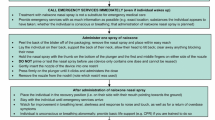Abstract
Purpose of Review
Rising opioid overdoses are a nationwide problem. This review aims to educate health care professionals on the various naloxone nasal formulations that are available.
Recent Findings
National data confirms a significant increase in opioid overdoses and a need for all health care professionals to recognize the importance of dispensing naloxone when indicated. With four options available (two intranasal and two intramuscular), naloxone may be dispensed with or without a prescription in many states.
Summary
Being aware of the current formulations and offering naloxone prescriptions to patients at risk are among the current recommendations for providers to impact addictive behaviors, thus, reducing the risk of overdose.


Similar content being viewed by others
References
Papers of particular interest, published recently, have been highlighted as: • Of importance •• Of major importance
Coffin P, Behar E., San Francisco Department of Public Health. Naloxone for opioid safety: a provider’s guide to prescribing naloxone to patients who use opioids. 2015. Available at: http://prescribetoprevent.org/wp2015/wp-
Centers for Disease Control and Prevention. QuickStats: rates of deaths from drug poisoning and drug poisoning involving opioid analgesics—United States, 1999–2013. Available at: https://www.cdc.gov/mmwr/preview/mmwrhtml/mm6401a10.htm. Accessed 1/7/2017.
The Opioid Epidemic: By the Numbers. In: Department of Heath and Human Services U, editor. Department of Heath and Human Services: Center of Disease Control. 2016
United States Department of Health and Human Services. Substance Abuse and Mental Health Services Administration Center. Drug Abuse Warning Network, 2011: National estimates of drug-related emergency department visits. Available at: https://www.samhsa.gov/data/sites/default/files/DAWN2k11ED/DAWN2k11ED/DAWN2k11ED.pdf. Accessed 1/7/2017.
• American Society of Addiction Medicine (ASAM). Opioid addiction 2016 facts and figures. Available at: http://www.asam.org/docs/default-source/advocacy/opioid-addiction-disease-facts-figures.pdf. Accesed 1/7/2017. Brief document providing the incidence of opioid related deaths, the misuse of opioid prescriptions, and the impact on special populations afflicted. The document provides the basis that a national opioid overdose epidemic exists in the United States.
Massachusetts Department of Public Health. Data Brief: Opioid-related overdose deaths among Massachusetts residents 2016. Available at: http://www.mass.gov/eohhs/docs/dph/stop-addiction/current-statistics/data-brief-overdose-deaths-nov-2016-ma-residents.pdf. Accessed 1/7/2017.
United States Department of Health and Human Services. Substance Abuse and Mental Health Services Administration Center. Drug Abuse Warning Network, 2013: National estimates of drug-related emergency department visits. Available at: https://www.samhsa.gov/data/sites/default/files/NSDUHresultsPDFWHTML2013/Web/NSDUHresults2013.pdf. Accessed 1/7/2017.
Cai R, Crane E, Poneleit K, Paulozz L. Emergency department visits involving nonmedical use of selected prescription drugs—United States, 2004–2008.MMWR 2010; 59:705–709.
•• Boyer EW. Management of opioid analgesic overdose. N Engl J Med. 2012;367:146–55. Review article that describes the epidemiology and pathophysiology of opioid overdose. It also reviews opioid toxicology, clinical manifestations, diagnosis, and treatment.
Massachusetts Department of Public Health. Naloxone rescue kit: standing order for dispensing naloxone rescue kits to individuals at risk of experiencing or witnessing an opioid-related overdose. Available at: http://www.mass.gov/eohhs/docs/dph/quality/boards/pharmacy/example-naloxone-standing-order-4-18-14.pdf. Accessed 1/7/2017.
NARCAN® (naloxone hydrochloride) nasal spray. Adapt Pharma. Available at: https://www.narcan.com/?gclid=CKXB8r-itdECFchKDQodN8YN1w. Accessed 1/7/2017.
Naloxone hydrochloride injection solution, Hospira. Available at: https://www.pfizerinjectables.com/products/Naloxone_Hydrochloride. Accessed 1/7/2017.
EVZIO (naloxone hydrochloride injection) auto-injector for intramuscular or subcutaneous use. Kaleo, Inc. Available at: https://evzio.com/patient/. Accessed 1/7/2017.
Robertson TM, Hendey GW, Stroh G, Shalit M. Intranasal naloxone is a viable alternative to intravenous naloxone for prehospital narcotic overdose. Prehosp Emerg Care 2009;13:512–515. Epub 09/05/2009.
Kelly AM, Kerr D, Dietze P, et al. Randomised trial of intranasal versus intramuscular naloxone in prehospital treatment for suspected opioid overdose. Med J Austr. 2005;182:24–7. Epub 01/18/2005
Traynor K. Experts weigh minimum naloxone dose as opioid crisis evolves. Am J Health-Syst Pharm. 2016;73:1892–4. Epub 2016/11/20
Barton ED, Colwell CB, Wolfe T, et al. Efficacy of intranasal naloxone as a needleless alternative for treatment of opioid overdose in the prehospital setting. J Emerg Med. 2005;29:265–71. Epub 09/27/2005
Weiner SG, Mitchell PM, Temin ES, et al. Use of intranasal naloxone by basic life support providers. Ann Emerg Med. 2014;64(4):S52. Abstract 144
Davis CS, Ruiz S, Glynn P, et al. Expanded access to naloxone among firefighters, police officers, and emergency medical technicians in Massachusetts. Am J Public Health. 2014;104:e7–9. Epub 06/13/2014.
•• Dwyer K, Walley AY, Langlois BK, et al. Opioid education and nasal naloxone rescue kits in the emergency department. West J Emerg Med. 2015;16(3):381–4. First and largest study to demonstrate the feasibility of ED-based opioid overdose prevention education and naloxone distribution to trained laypersons, patients, and their social network. Among the participants who witnessed another individual experiencing an overdose, 32% used a naloxone kit to reverse the overdose.
United States Department of Health and Human Services. Substance Abuse and Mental Health Services Administration (SAMHSA). Opioid Overdose Prevention Toolkit. Available at: https://www.samhsa.gov/capt/tools-learning-resources/opioid-overdose-prevention-toolkit. Accessed 1/7/2017.
National Conference on State Legislation. Drug Overdose Immunity and Good Samaritan Laws. Available at: http://www.ncsl.org/research/civil-and-criminal-justice/drug-overdose-immunity-good-samaritan-laws.aspx. Accessed 1/7/2017.
Author information
Authors and Affiliations
Corresponding author
Ethics declarations
Conflict of Interest
Dr. Alosaimy, Dr. Santos, and Dr. Fanikos declare that they have no conflict of interest.
Human and Animal Rights and Informed Consent
This article does not contain any studies with human or animal subjects performed by any of the authors.
Additional information
This article is part of the Topical Collection on Pharmacology of Acute Care
Rights and permissions
About this article
Cite this article
Alosaimy, S., Santo, R.A. & Fanikos, J. Prescribing Naloxone: Managing and Preventing Opioid-Related Overdoses. Curr Emerg Hosp Med Rep 5, 11–15 (2017). https://doi.org/10.1007/s40138-017-0124-7
Published:
Issue Date:
DOI: https://doi.org/10.1007/s40138-017-0124-7




